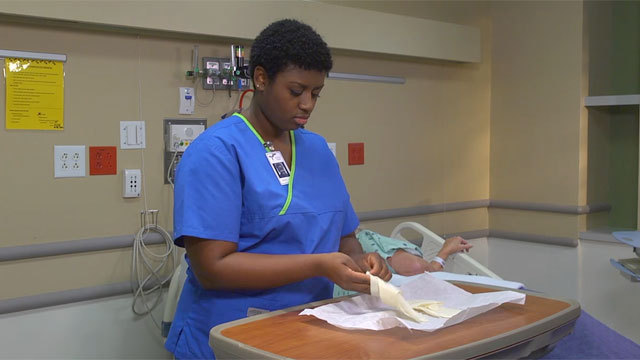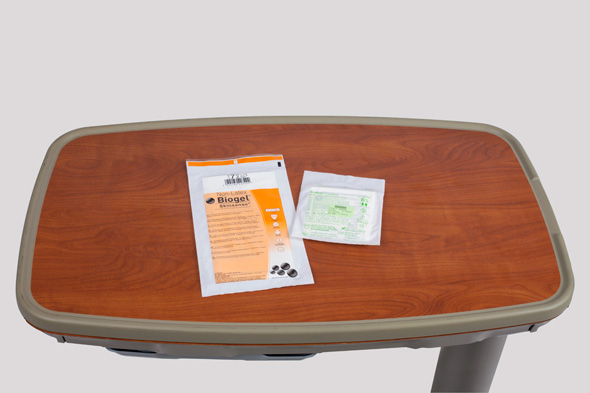Infection Control
Select a Skill:
- » Establishing and Maintaining a Sterile Field
- » Adding Items to a Sterile Field
- » Pouring A Sterile Solution
- » Using a Prepackaged Sterile Kit
- » Performing Sterile Gloving
Take the Review Test:

Safety
- Choose latex-free or synthetic gloves if the nurse or patient is allergic to latex, is at high risk for latex allergy, or has a suspected sensitivity to latex.
- Do not use gloves from a torn or wet package of sterile gloves. The gloves in such a package are considered contaminated. Signs of water stains on the package indicate previous contamination by water.
- Select the proper glove size. The gloves should not stretch so tightly over the fingers that they tear easily, but they must be tight enough to pick up objects easily. There is less chance of contamination if you wear the correct glove size.
- Interlock your fingers, and hold your hands together in front of your body and above the level of your waist while waiting to handle sterile items.
Equipment
(Roll cursor over items to see labels)

Package of properly-sized sterile gloves - latex
Package of properly-sized sterile gloves - synthetic nonlatex
Delegation
Nursing assistive personnel (NAP) may assist with skills that include the application and removal of sterile gloves. However, many procedures that require the use of sterile gloves cannot be delegated to NAP. Be sure to inform NAP of the following:
- Explain the reason for using sterile gloves for a specific procedure.
Preparation
- Consider the patient’s risk of infection, including factors such as preexisting conditions and the size or extent of the area being treated.
- Inspect your hands for cuts, hangnails, open lesions, and abrasions. In some settings, you are allowed to cover any open lesion with a sterile, impervious transparent dressing (check agency policy). In some cases, the presence of such a lesion may prevent you from participating in a procedure.
- Consider the type of procedure to be performed, and consult your agency’s policy on the use of sterile gloves.
- Examine the glove package to determine if it is intact and dry, with no water stains.
- Before applying latex gloves, assess the patient for the following risk factors:
- Previous reaction to the following items within hours of exposure: adhesive tape, a dental or other face mask, golf club grip, ostomy bag, rubber band, balloon, bandage, elastic underwear, IV tubing, rubber gloves, or condom
- Personal history of asthma, contact dermatitis, eczema, urticaria, or rhinitis
- History of food allergies, especially to avocado, bananas, peaches, chestnuts, raw potatoes, kiwi fruit, tomatoes, or papayas
- History of adverse reactions during surgery or a dental procedure
- Previous reaction to a latex product
- Select the correct size and type of gloves.
- Place the glove package near the work area.
Follow-up
- Assess the patient for signs of infection, focusing on the area being treated.
- If a patient develops an allergic reaction to latex:
- Immediately remove the source of latex.
- Bring emergency equipment to the bedside. Have an epinephrine injection ready to administer, and be prepared to initiate IV fluids and oxygen.
Documentation
- It is not necessary to record the application of gloves. Record the specific procedure performed and the patient’s response and status.
- If the patient has an allergic reaction to latex, record it on the vital sign flow sheet. Note the specific type of reaction and the patient’s response to any emergency treatment provided.
Review Questions
1. Which action would the nurse perform first when preparing to apply sterile gloves?
 Perform hand hygiene.
Perform hand hygiene. Place the package on a stable, flat surface.
Place the package on a stable, flat surface. Assess the glove packaging for wetness or tears.
Assess the glove packaging for wetness or tears. Open the outer packaging.
Open the outer packaging.
2. When are sterile nonlatex gloves recommended for a sterile procedure?
 When there is a possible sensitivity issue
When there is a possible sensitivity issue When the staff member prefers them
When the staff member prefers them When latex gloves are not conveniently available
When latex gloves are not conveniently available  When the patient prefers them
When the patient prefers them
3. What is the most important step the nurse can take to minimize the risk of tearing a sterile glove when applying it to the hands?
 Using powdered sterile gloves
Using powdered sterile gloves Keeping the fingernails trimmed and smoothly filed
Keeping the fingernails trimmed and smoothly filed Selecting the proper glove size
Selecting the proper glove size Drying the hands thoroughly before applying the gloves
Drying the hands thoroughly before applying the gloves
4. After applying sterile gloves, the patient states she is uncomfortable and would like to move to her left side. What is the best way for the nurse to keep the gloves sterile while waiting for nursing assistive personnel (NAP) to position the patient for a sterile dressing change?
 Interlocking the fingers and keeping the hands above waist level
Interlocking the fingers and keeping the hands above waist level Keeping the arms at the sides, with elbows bent and gloved hands pointing up
Keeping the arms at the sides, with elbows bent and gloved hands pointing up Leaving the room momentarily
Leaving the room momentarily  Stepping back from the bedside where NAP are working
Stepping back from the bedside where NAP are working
5. Which protocol does not vary among institutions?
 Acceptability of wearing artificial nails in patient care areas
Acceptability of wearing artificial nails in patient care areas Use of impervious transparent dressings to cover open lesions on nurse’s hands during sterile procedures
Use of impervious transparent dressings to cover open lesions on nurse’s hands during sterile procedures Use of sterile gloves for sterile procedures
Use of sterile gloves for sterile procedures Sterile gloves are only available in “one size fits all”
Sterile gloves are only available in “one size fits all”
You have completed the Review Questions for this skill. To take the Review again select the Start Over button. To proceed to another skill select from the dropdown menu. Select the Home or Back button to proceed to the next section.

